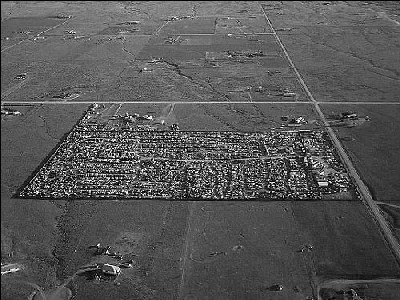Property rights campaigns--nationally funded and organized?
 Image from A Field Guide to Sprawl by Dolores Hayden and Jim Wark.
Image from A Field Guide to Sprawl by Dolores Hayden and Jim Wark.(Today's newspapers report that the Oregon Supreme Court has upheld Measure 37. See "High court upholds Measure 37"from the Salem Statesman-Journal.)
In the 1980s, conservative foundations like the Olin Foundation and various entitities controlled by Richard Scaife (who, ironically, is pro-historic preservation) funded the creation of conservative newspapers on college campuses across the country, modelled after the Dartmouth Review.
I think it's likely that campaigns against urban growth boundaries, smart growth, and historic preservation are funded and organized similarly. For developers, and the other allied entities that benefit from sprawl, it's a good investment to ensure that the sprawl development paradigm continues forward unabated.
While it might be reasonable in part to compensate land owners for lost potential revenue from the sale of property that is managed, who is to compensate states, counties, and local governments for the huge costs shouldered in support of sprawl--e.g., the cost of building infrastructure including roads, schools, and the provision of other municipal services usually far outweighs the increased revenue from sales and/or property taxes?
There are few studies of the costs of various types of development, but one, "Settlement Pattern & Form w/Service costs analysis" from the municipality of Halifax in Nova Scotia finds that traditional suburban development forms cost more to service than denser urban forms.
It is well known in municipal finance that localities prefer to have commercial development--office and retail--rather than residential development, because the former generally is more profitable than the costs of servicing it (this sometimes isn't true for big box stores in small localities, which find that police and other emergency services costs skyrocket). On the other hand, providing services to residents is usually a loss-ridden proposition as property tax revenues aren't nearly enough (e.g., the cost of educating one child is much more than the revenue in property taxes from the average household).
________
Local defenders of historic preservation and smart growth efforts are often active without much in the way of support from national groups. The national groups need to step up and provide organizational resources directed to the support of local groups, in order to ensure that sustainable land use and resource planning policies can continue.
The alternative is the continued loss of open space and the financial (and other) failures of the center cities and inner ring suburbs, as development continues to move farther and farther out from the core, and further deconcentrates.
 Die cut from the Fairfax County Virginia planning publication The Vanishing Land, published in 1962!
Die cut from the Fairfax County Virginia planning publication The Vanishing Land, published in 1962!Index Keywords: sprawl; property-rights



0 Comments:
Post a Comment
<< Home